How Is The Garden Mural A Metaphor For Wehling
Here's my 17-page research paper on why Over The Garden Wall is the new religion of millennials
![]()
As tempting as the idea was — my former pop culture studies teacher assured me that, if I put in the time to make it even more academic, I could submit it to a journal — I decided my thoughts would get far more visibility on the prestigious, lauded outlet of Medium.com.
Originally written last December, the paper has s ince been very lightly edited to eliminate some "college-ese," as is prone to happen when I get all my best ideas in the 11th hour. I did not edit out all the multiple uses of "millennial," and I would caution all readers from taking the definition as a too-literal stereotype of an entire generation — I think it's a useful categorization to look at generational differences, but ultimately it's not the strongest word choice, and I don't know how to fix that.
The essay does include a brief summary of Over The Garden Wall for non-viewers, but really, you should just watch it. It's $10 on Amazon .
You can view a printer-friendly version here . Images are taken from some of the slides I used in the accompanying classroom presentation, as well as gifs from Giphy and Tumblr.
Abstract
Religious and secular media are often portrayed at odds with each other, but in the case of popular new media forms, including animated cartoons formerly restricted to the domain of children, teens and adults are turning to these shows and their corresponding online communities to find their own spiritual fulfillment. In this essay, I chose the Cartoon Network miniseries Over The Garden Wall to semiotically examine evidence of this phenomenon. Its themes, characters, and fan community theories about its analogous nature to Dante's Inferno make it a strong candidate for cultural sign analysis. The escapist powers of fiction over the individual mind are already well-documented, but what about animation, specifically, leads to an unusually loyal devotion found in greater concentrations than even the fandoms of live-action TV shows?
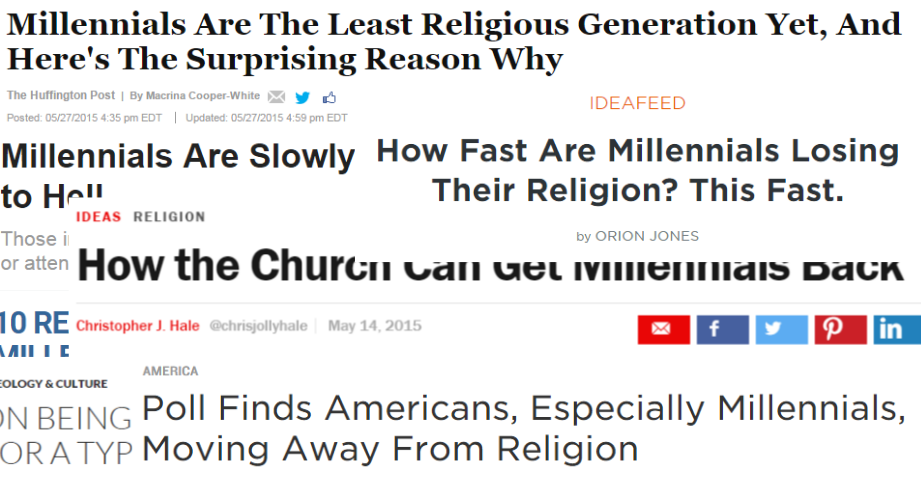
Introduction
Today's millennials are tired of the "old-time religion." Journalist Cathy Lynn Gossman reported to USA Today in 2011 that "44 percent told the 2011 Baylor University Religion Survey they spend no time seeking 'eternal wisdom,' and 19 percent said 'it's useless to search for meaning.'" An increasing number of individuals greatly prefer secular-humanist philosophy over religion and even over atheism. They do not care to care enough.
Why is this happening, and where did the millennials go?
My proposed answer: animation.
Animation has often been perceived as the low culture of cinema, but its modern-day universal appeal for all ages — cartoons for babies and cartoons for kids and cartoons for teens and cartoons for young adults and cartoons for older adults — have allowed it to grow in diversity. The idea of cartoons as juvenile is diminishing to no more than a stereotype born in earlier decades, particularly the 1980s in which "Saturday morning cartoons" became a medium solely for merchandising and marketing, rather than storytelling.

In 2013, former Adventure Time creative director Patrick McHale published the magical realism/fantasy TV miniseries Over the Garden Wall on Cartoon Network. While it never aired on the late-night Adult Swim programming block, its most outspoken fans are about 20 years old (survey, November 30th, 2015): old enough to effectively propagate fandom on social media, but, more importantly, old enough to appreciate its surface-level predictable plot twists, not from an angle of surprise but rather nostalgia.
Spoilers follow: The show, comprised of only 10 episodes and each 10 minutes in length, follows the adventures of two young step-brothers — the awkwardly teenaged Wirt and the precocious child Greg — who, on their Halloween night out on the neighborhood, mistakenly fall over a garden wall (literally) and into a spooky, Americana-infused landscape identified only by its fairy tale-esque inhabitants as "the Unknown." In each episode, the kids encounter a diverse selection of the Unknown's denizens, who all live in fear of a being known as "the Beast" who (spoiler alert) feeds off the Unknown's inhabitants, who, when they give up on their problems, turn into edelwood trees, which the Beast then consumes.
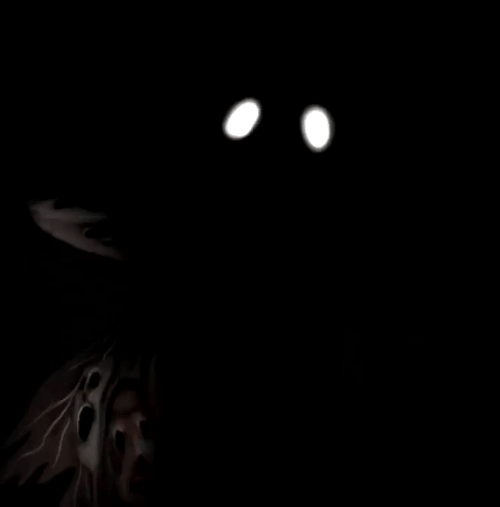
Over The Garden Wall falls into a category of cartoons from the 2010s era of cable animation that maintain an all-ages appeal (unlike the offerings on the Adult Swim programming block) while distinctly offering a contemplative depth for older viewers. This category includes Adventure Time (2010-present), My Little Pony: Friendship is Magic (2010-present), Gravity Falls (2012-present), and Steven Universe (2013-present). These cartoons are known for their real-world social commentaries and surprisingly mature treatment of their intended audience, such as a lack of preachy moralizing and unabashed quotationalism of other pop culture media. Because of these features, they have retained cult-like status among many college-age millennials trying to reclaim elements of their nostalgic youth while facing the increasing pressures of adulthood.

Method
I will analyze this cultural text through the semiotic method, as described independently by Charles Sanders Peirce and Ferdinand de Saussure, and applied to popular culture by Roland Barthes, who "[revealed] how phenomena that may look like mere entertainments can hold profound political or ideological significance" (Maasik, 2015).
Hereafter, the show will be referred to as OTGW for brevity's sake. Additionally, rather than analyzing episode-by-episode, I will be addressing the show's online reputation, as well as its overarching themes and main characters, as the context in which the question of modern-day religion can be addressed.

Literature Review
There are two trains of thought that support the thesis that OTGW's themes represent the contemporary struggle between religion and spirituality among young adults. I will first address the religious aspect, and then, the relevancy question: why does it matter that an animated cartoon is the medium for this message?
PBS Idea Channel, a series of informal Youtube essays hosted by Mike Rugnetta on the intersection of philosophy with pop culture franchises that appeal to today's 18–24 demographic, proposed the thesis that faith (and the lack thereof) is what differentiates OTGW's protagonists, Wirt and Greg, in a vlog published December 2014 entitled "Is Over The Garden Wall About Having Faith?" The way that they respectively respond to the Unknown and the Beast is driven by their respective outlooks toward pessimism and optimism. However, Rugnetta eloquently deepens his argument by citing 19th-century Danish philosopher Søren Kierkegaard's concepts of the knight of resignation and the knight of faith as a more fuller explanation for Wirt and Greg's behavior on-screen.
Kierkegaard wanted to learn why people choose to have faith in the first place. In his Fear And Trembling (1843), he explained the idea behind his "knight of faith" and "knight of infinite resignation" by placing them in a hypothetical scenario where each is in love with a princess. The knight of resignation "is not afraid of letting love creep into his most secret, his most hidden thoughts, to let it twine in innumerable coils about every ligament of his consciousness — if the love becomes an unhappy love, he will never be able to tear himself loose from it." While the knight of faith goes through the same pains as the first, he ultimately says, "'I believe nevertheless that I shall get her, in virtue, that is, of the absurd, in virtue of the fact that with God all things are possible.'" The knight of faith resigns not himself, but his perception of the absurd unknown before him, substituting his own interpretation for the trust in God's knowledge.
How is this relevant to everyday life, especially for college-age adults? In research regarding the intersection of science and religion as truth-seeking approaches to philosophy, C. Scheitle (2011) found that "many more students move away from a conflict perspective to an independence/collaboration perspective than vice versa" (p. 185). In other words, they were just as likely to respect religion as they were to respect science.
Mayrl and Oeur (2009), professors from the University of California-Berkeley, conducted a study of the effects of the college experience on young adults' personal religious behaviors and attitudes. Overall, they found that "although most students affiliate with a religious tradition and believe in God, fewer students attend religious services and pray regularly," and that "recent attempts to explore student spirituality [as opposed to conventional religious behavior] have been hampered by fuzzy measures that in many cases raise more questions than answers" (p. 263). A closer inspection of the paper at hand can reveal other important clues about young adults' attitudes about religion and how they consume those in the context of media.
Why young adults specifically? OTGW presents some of these deeper questions about life and religion that may very well "fly over the heads" of child audiences. In particular, the culture of "kidults" is what fueled the show's creation in the first place. A conference paper from H. J. Lee (2010) about "kidult" culture — the teen-like consumer attitudes among adults — explains how the growing trend of cable animation programming aimed at adult audiences, whether it is shown on the late-night Adult Swim block, is in essence a postmodern pastiche of the nostalgic cartoons that OTGW's viewers grew up with in the late 1980s to early 2000s. Even the resurgence of all-ages-friendly, mainstream animations from Pixar and Disney have lately touched on themes that are more relatable to adults. Precisely because the "kidults" are so unashamedly in touch with a childlike approach to their lifestyle demands, they prefer these messages over the stereotypical, adult-marketed, live-action media fare.
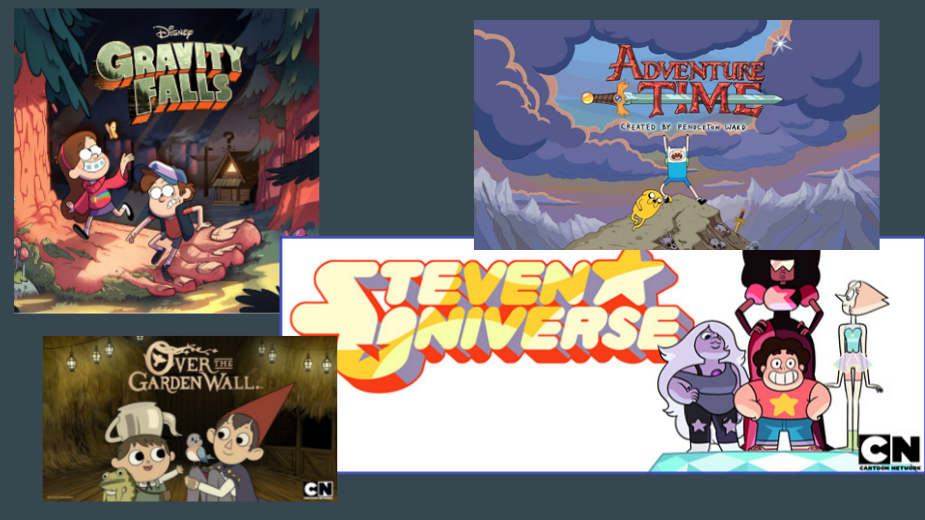
Finally, one of the most important critical analysis theories pertaining to OTGW specifically comes from the fan community. In a Tumblr post published November 18, 2014, the user GlobeGander composed an in-depth comparison of the uncanny parallels between OTGW and Dante's Inferno that reads much more like a thoughtful English class analysis than a typical blog post. Because of its professional tone and strong thesis, I have decided to include it as a legitimate, academic contribution to the conversation on religious philosophy as disseminated through animation. GlobeGander explains how the personalities of Wirt, Greg, and Beatrice are at times both antitheses and clones of their respective Inferno counterparts, Dante, Virgil, and Beatrice. Additionally, episodes 2–10 each correspond to one of the nine circles of Hell. While most OTGW viewers have likely not read Dante's writing, its study is not required to understand almost immediately that there appears to be some intentional moral theme embedded throughout the show. How millennials react to those themes and even unintentionally embody them is what the analysis section explores.
From October 19 to November 30, 2015, I conducted a survey of 213 self-declared fans of Over The Garden Wall on Facebook, Reddit, and Tumblr, in order to approximate a sense of who watches the show. I was primarily interested in gathering information about their religious attitudes, so I had them respond to a series of statements such as "I identify with a religious group" or "I could consider myself 'spiritual.'" I used this data in addition to my secondary research to aid in confirming my theories about the state of millennial religiosity. Due to its unpublished nature, it is classified according to APA style as a personal communication, and thus it has not been cited in the References page.
Through these various texts, the theme of cartoons as a deliberately "childish" medium through which to convey a cultural message about the transformation of modern religion into spirituality becomes not just obvious, but necessary. Animation brings with it a cult-like devotion that becomes meta-emphasized by a semiotic analysis of OTGW.
Analysis
While OTGW appears to fall squarely in the realm of "kidult" culture, of which much has been written already, the connotations of this term and the way it is described in scholarly works seem to suggest a condescending perception of the millennials who willfully choose to engage with these shows. The kidults in question are described as though they are not able to adjust to the full responsibilities of true adult life, and so they hold on to their vestigial past, represented in cartoons, as "signify[ing] the social anxiety of 'adulthood in crisis' or 'the death of the grownup" (Lee, 2010).
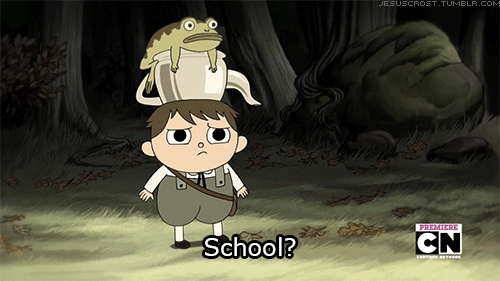
However, I propose an alternative term: the "adult-olescent." Simply by changing the order of the words that represent juvenile and grownup demographics, more emphasis is placed on the idea of a conscientious adult who purposely chooses to engage with content as a critical consumer. This type of adult judges media based on desirable aesthetic qualities rather than by its intended audience; therefore, an interest in children's media should be classified no differently than an interest in adult-oriented media. This change in terminology also recognizes the intentions of these shows' creators, many of whom fall into this "adult-olescent" category themselves and write their TV scripts keeping in mind this exact audience of others like them, not just the network's desired child demographic.
These "adult-olescent" shows embrace their viewers' childlike fears about the unknown mysteries and challenges of adult life by combatting it through different stylizations of Campbell's description of the hero's journey (Maasik, 2015). The protagonists of Gravity Falls rely on their powers of witty thought and logical deduction to save the day. On the other hand, Adventure Time fully embraces its absurdity, and questions not even the most ridiculous of strange occurrences within its post-apocalyptic setting. These shows all arguably represent different philosophical approaches to dealing with the viewer's own fears, and OTGW's particular method of attacking the millennial unknown includes religious connotations. Even to the religion-averse viewer, this is hardly a surprising revelation among the fan community. For instance, Tumblr user GlobeGander's semiotic analysis of each episode as an equivalent for the sin featured in Dante's respective circle of Hell not only reinforces the show's spiritual connotations, but also the very fact that such a deep reading of the show has taken place confirms these viewers as active, critical consumers, rather than the passive viewers of "kidult" theory. Furthermore, "despite its seeming predominance, the conflict model of understanding religious and science issues does not seem to have much support within the [college] undergraduate population" (Scheitle, 2011), which reflects the idea that no one of these shows is deemed to be more ideologically true to the millennial worldview than another. They are not the vigilante atheists of some Internet circles, but tend to find value in a variety of philosophies, provided they are isolated from any potentially problematic dogma.
As an aside, "there are tantalizing findings that interest in spirituality… is quite high" (Maryl, 2009), but the lack of objective differentiation and specificity around what constitutes spiritual versus religious practice means that the two terms are used interchangeably in the analysis portion of the essay as a catch-all for the drifting, questioning mind of the millennial.
Fandom is not an original concept, as far as discussing the connotations of religious-like rallying around these cartoons. Almost as soon as millennials derive meaning from a media text not found elsewhere, a fanbase around that text is born. Because of the level of carefully crafted nostalgia in these shows, they have created a powerful aesthetic for viewers to identify with — indeed, it might be as powerful a yearning as the search for spirituality, for is it not often that looking to the tropes of the past fills people with gratitude and even enlightenment?

Interestingly, OTGW's format as miniseries rather than a full-length TV season itself echoes the religious pamphlets of old that Christian missionaries and soapbox preachers would distribute to their listeners. From episode to episode, OTGW can be read like a contemporary Christian worship service. Each episode contains at least one song, whether a short whimsical tune by the main characters or the main thematic hymn, "Into the Unknown," as crooned in the baritone voice of jazz singer Jack Jones (off-screen):
Led through the mist / By the milk-light of moon / All that was lost, is revealed / Our long bygone burdens, mere echoes of the spring / But where have we come, and where shall we end? / If dreams can't come true, then why not pretend? / Oh how the gentle wind / Beckons through the leaves / As autumn colors fall.
Such a lyrical, poetical description of nature falls in line with the Old Testament's musing psalms, or rather, the colonial-era religious revival interpretation of those psalms. If OTGW is a worship service, then each episode is a moving tableau of symbolic imagery and sermons on the evils, as well as the goodness, of life. Although this analogy may seem sacrilegious to the organized Christian community, "the more time and investment religion requires of [millennials], the less likely students are to engage" (Maryl, 2009), and so it becomes natural to think that this generation might turn to some forms of Internet media for personal fulfillment as they would for entertainment or academic purposes.
In this hypothetical "sermon," Wirt and Greg are the unwitting actors in these morality plays, and each respectively represents the two different phases of outlooks young millennials when they are faced with the challenges of deriving philosophical and religious meaning in their lives for the first time away from home. "The Unknown," in this sense, becomes a very practical metaphor for the wilderness of doubt that each young adult-olescent faces when they attempt the journey of self-actualization.
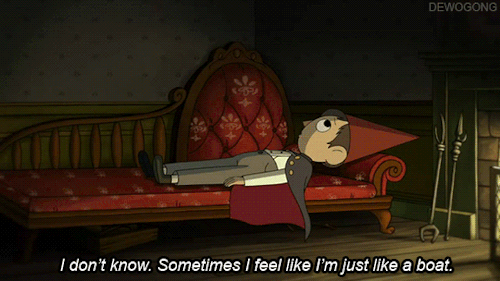
Let us first, then, examine this setting of the Unknown so that there is later context for Wirt and Greg's actions. Their period of wandering in the wilderness of the Unknown echoes Campbell's description of the hero's journey (Maasik, 2015) as well as an ascetic period of abstinence from worldly pleasures typically found of the actors in religious accounts. The main characters sleep outside in the cold and are seen eating only very occasionally. The emphasis is on the spiritual journey they undertake to find their way home, and to do that they frequently dismiss or neglect even the simplest of worldly pleasures that the Unknown's inhabitants are frequently distracted and beset by, such as a schoolteacher overcome by grief over a lover suspected of cheating (lust) and a wealthy businessman who gives voice to his extreme loneliness after realizing how lost he is in the corridors of his own mansion (greed) (GlobeGander, 2014). Not all characters in the Unknown are shadowy or double-crossing, but they are all rather selfish and full of their own whims, much as the real world of selfish-minded young adults tends to run. In each one's quest to become the main character, the bigger picture of the absurdity of the "Unknown" is lost.
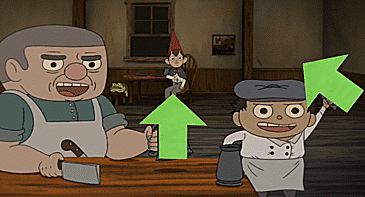
Although Wirt's denotation is the teenage mind, connotatively he is the skeptical millennial. In particular, is all too eager to dismiss the advice of the Woodsman, and thus by extension, so is the viewer, even though Wirt's introduction in episode 1 immediately defines him as an insecure and unaware teenager (thereby mocking the skepticism of the same type of millennials). Wirt's clear disdain for his stepfather additionally reveals the nature of the show's attitude towards adults. Adults are shown as not just being scary, but as having their own selfish interests in mind. This attitude resonates with teens and with the disenchanted millennials of our time (see #BLM and any other recently visible socio-political movement).
Ironically, it is the adults who are the most wisest, and also most foolish, among the Unknown's inhabitants. This is most strikingly demonstrated in episode 7, "The Ringing of the Bell," in which Greg and Wirt immediately assume that the monstrous-looking Auntie Whispers is a cannibal, when in fact she is trying to protect them from her innocent-looking but secretly possessed, man-eating protégé Lorna. Yet ironically, Wirt and Greg (and the audience) realize after the fact that Auntie Whispers had the power to exorcise Lorna all along, yet did not do so because of her own selfish, albeit sympathetic, desire for someone to stay and live with her. The inhabitants of the Unknown prefer to stay where they are, wallowing in their sorrows, rather than move on with their potential lives (GlobeGander, 2014). This distrust of the older generations is therefore not unfounded in the least, and it leads to to Wirt's further decline to despair in his role as the "knight of resignation," allowing himself to become obsessed with the inevitability of their stagnant wanderings (Kierkegaard, 1843).
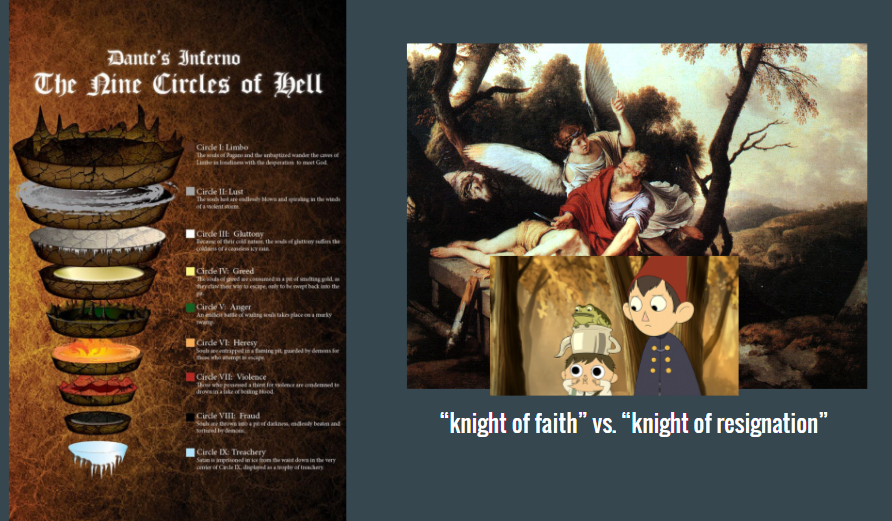
Greg, on the other hand, is the happy-go-lucky knight of faith explained by Kierkegaard's work, and that of PBS Idea Channel (2014), who has relinquished his own desires in the hope of absurdity, almost as if God was literally a deus ex machina plot device. He represents the aspiring optimism of all millennials, in spite of their skeptical views on some issues. Even in life-threatening situations, he acts genuinely surprised more than scared, and he carries himself independently from his step-brother Wirt, regarding their relationship as an equal brotherhood where each helps out the other. He is the more traditionally religious of the two, compared to Wirt's infinitely vague "spirituality" seen in his perpetual musings on love (if you can call a crush on the actor in the school's mascot costume "love"). Greg "infinitely resigns" his faith and then "takes it back on the strength of the absurd" (PBS Idea Channel, 2014).
The Beast is a metaphor for the millennial fear not just of the "Unknown" in life, but of the fears that they face from expressing any kind of spiritual or religious identity. The Beast literally lives off the despair of humans in the Unknown. The only way to defeat him is with hope. But how Wirt and Greg each choose to react to the Beast at the show's finale, using different approaches to hope, strongly symbolizes how each person's individual approach to resolving personal questions of right and wrong are not a one-size-fits-all solution. Greg sees Wirt begin to turn into an edelwood tree, and realizes that in order to save his brother from impending doom, he must make the ultimate sacrifice of faith by resigning himself to the Beast's demands. The Christian parallels are of obvious note here, in the analogy of the worship service. Greg fulfills his faith in a typically altruistic way reminiscent of religious tropes.
When Wirt realizes that Greg is truly missing, he panics and immediately seeks out the Beast. For the first time, he has overcome the fears in his mind resulting from inaction. The Beast tries to trick Wirt into making a deal with him to become his servant in exchange for the preservation of Greg's spirit, but Wirt almost immediately sees through the Beast's lies in an unusually rational way (given his rhetorical train of thought in the past): "I'm not going to spend the rest of my life walking around the woods carrying some lantern." He steadfastly declares his intentions to go back home with Greg, and leaves the Beast's fate in the hands of the originally deceived servant, the Woodsman. While Greg fulfilled his own worldview of infinite faith and optimism in the absurdity of the Unknown's elements taking care of him whenever he needed it, Wirt remained the knight of resignation till the very end, but not to his own demise — rather, he turned his pessimism into realism, and saved the day by acting practically on that knowledge instead of wistfully pondering about it in his usual poetic manner.
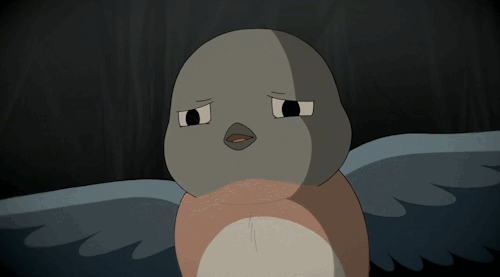
Over The Garden Wall does not demonize religion nor the conscientious lack of it. The show's morals embrace both the active side of pursuing enlightenment as well as the passive, meditative side, through the lens of Greg and Wirt as stand-ins. It reflects millennials' religious attitudes by reflecting the big questions that occur in every young millennial's life, and the similar diversity in ways to reconcile with the seeming hopelessness of society by turning to organized religion or informally practiced spirituality. The abstractness of these terms, as used by millennials, further clouds the objectivity of truthful answers about the meaning of life, which perfectly summarizes the reason why these terms remain morally relative in the first place.

Conclusion
What is the evolution of religion moving forward in new media? How does the definition of religion, and of spirituality (assumed in studies to be a broader, informal application of religion), change with the rise of new media?
Already we are starting to see how the definition of religion has been subverted by a broader and more innocent term, "spirituality," in millennials' quest for existential fulfillment. To confirm this, I surveyed over 200 millennial-aged OTGW viewers found in Reddit, Tumblr, and Facebook fan communities. More than half indicated that they did not attend church or worship services, but 40 percent still chose to identify as "spiritual." Only 10 percent identified as both spiritual and religious, and less than 5 percent identified as only religious. I did not ask for each individual's denotative distinction between these terms, but even from the limited depth of results I obtained, there is definitely a strong connotative difference between the two words among millennials.
Religion implies a behavior; spirituality implies a continuous, evolving experience.
What other social systems could possibly change due to tropes from new media? Just as old media, including traditional TV network shows, books, and classical art represent the social structures of the old world, so does the new, highly modular media represent the much more nuanced social structures of the modern world. Religion, as understood in a Christian way, is giving way to less formalized world religions, such as Buddhism, as well as the prevailing attitude of "who cares?" Continued observation of how millennials respond to old-world systems through devotion to, and consumption of, new media forms, will remain a fascinating field of study for decades to come, as they have already begun to change the connotations of the most ordinary words.
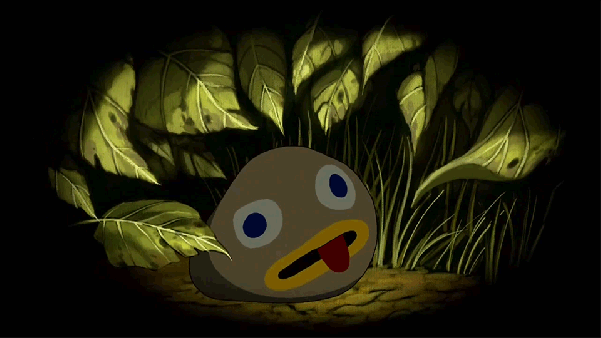
References
Gossman, C. (2011, December 29). Many say 'So what?' to religion, atheism. USA Today.
Is Over The Garden Wall About Having Faith? | PBS Idea Channel. (2014, December 10). Retrieved October 20, 2015.
Kierkegaard, S. (1843). Fear And Trembling (W. Lowrie, Trans.; T. Brock & W. Brock, Eds.). Retrieved October 19, 2015.
Lee, H. J. (2010). Every Night Is a Saturday Morning: Examining Kidult Culture Through Cartoon Network's Adult Swim. Conference Papers — International Communication Association, 1.
Maasik, Sonia; Solomon, Jack (2015). Signs of Life in the USA: Readings on Popular Culture for Writers. Bedford/St. Martin's. Kindle Edition.
Mayrl, D., & Oeur, F. (2009). Religion and Higher Education: Current Knowledge and Directions for Future Research. Journal for the Scientific Study of Religion, 260–275.
Scheitle, C. (2011). U.S. college students' perception of religion and science: conflict, collaboration, or independence? A research note. Journal For The Scientific Study Of Religion, 50(1), 175–186.
Wirt's Inferno/Dante's Unknown: Allusions to the Divine Comedy in Over the Garden Wall. (2014, November 18). Retrieved November 23, 2015, from http://globegander.tumblr.com/post/102962248481/wirts-infernodantes-unknown-allusions-to-the
How Is The Garden Mural A Metaphor For Wehling
Source: https://medium.com/@theberlz/heres-my-17-page-research-paper-on-why-over-the-garden-wall-is-the-new-religion-of-millennials-4ddb51982d29
Posted by: gonzalesbeepargang97.blogspot.com

0 Response to "How Is The Garden Mural A Metaphor For Wehling"
Post a Comment